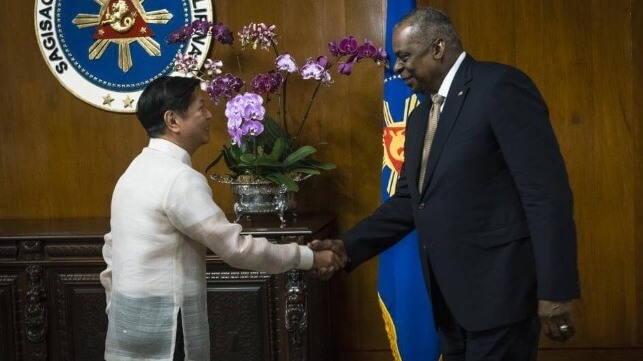Opinion: China's Fumbles in S. China Sea Boost U.S.-Philippine Ties
To understand why the warming US–Philippines relationship is China’s own doing, it is helpful to look back to the foreign policy stance of Ferdinand Marcos’ populist predecessor.

[By Makoi Popioko]
The Philippines recently granted the United States access to four more military bases, reportedly including at least one strategic location facing Taiwan. It’s an agreement sealed less than a year into the first term of President Ferdinand Marcos Jr – a decision compelled by China’s own behaviour.
To depict Marcos’ approach towards the United States as a mere reversal of former president Rodrigo Duterte’s China policy would be short-sighted. A more appropriate characterisation of the reset in US–Philippines relations would be to look at it as a consequential evolution of Duterte’s foreign policy legacy.
To understand why the warming US–Philippines relationship is China’s own doing, it is helpful to look back to the foreign policy stance of Marcos’ populist predecessor.
In 2016, China had a promising window of opportunity to keep the Philippines within its sphere of influence, with Duterte flipping the Philippines’ pro-American status quo upside down soon after his election. His tradition-breaking foreign policy pivot towards China officially kicked off right when Manila won its case against Beijing in an international tribunal in The Hague over the latter’s sweeping maritime claims in the West Philippine Sea (the name the Philippines government calls certain parts of the South China Sea). The daring policy decision did not come without legitimacy challenges but was largely muffled by Duterte’s popularity and political dominance over the three branches of government.
The pursuit of trade, aid and economic interests was the subtext of Duterte’s China policy. His flagship Build, Build, Build Program was a massive US$160-billion infrastructure undertaking that demanded more resources than were then available from existing economic partners. China’s Belt and Road Initiative (BRI) was a promising resource for Duterte’s infrastructure ambitions.
Under Duterte’s predecessor – the late president Benigno Aquino III, who took China to court over South China Sea claims – Chinese funding was largely inaccessible. So to woo China, Duterte needed to stage a loud, scandalous divorce drama with the United States. He pursued this by cursing former US president Barack Obama over his comments on Duterte’s harsh anti-drugs campaign, and repeatedly threatening to terminate and eventually abrogate the Visiting Forces Agreement.
Decoupling from the United States was an easy task for Duterte who has long held an anti-American worldview, aggravated by US criticism of the strongman’s murderous war on drugs.
China’s President Xi Jinping reciprocated with a warm welcome for Duterte during a “milestone” visit to Beijing soon after the Filipino president’s election. Pledges were made, and some projects commenced. However, many of the pledges remained promises.
Fast forward to 2022, Duterte stepped down from office with disappointing dividends from his attempts to benefit from BRI. Beijing refused to cease harassing Filipino fisherfolk operating within the contested waters and even expanded its militarisation of the artificial islands in South China Sea.
Duterte’s experience showed that China is proving to be an unreliable partner. And signs of a widening chasm between China and the Philippines were abundant in the former president’s last year in office, which also marked the beginning of US-Philippines realignment. Washington poured in resources to Manila. The Philippines was the largest recipient of US military assistance in the Indo-Pacific region. Duterte in July 2021 restored VFA after a visit by US Defence Secretary Lloyd Austin. The Philippines’ Defence chief Delfin Lorenzana was back in Pentagon a month before the elections won by Marcos.
Beijing left Marcos with little choice but to break away further. China ignored the Philippines’ pending loan applications even after Manila relayed an ultimatum. Incidents of Chinese aggression against the Philippine Navy and some fisher vessels happened within Marcos’ first few months.
In a further sign the shift cannot be all down to a change of administration, Marcos’ key defence and foreign policy architects are Duterte-appointed officials retained or reassigned into allied positions. Duterte’s ambassador to the United States also continued in the role. Marcos’ Defense chief was first appointed by Duterte as Armed Forces chief in 2018 and later as peace adviser and vaccine czar. The largely American-trained Philippine Armed Forces played a countervailing role in Duterte’s China policymaking.
It would not be surprising if the internal workings of the recent US agreements signed less than a year since Marcos took office actually began in the concluding months of Duterte.
To mend the policy fumble, Beijing will need to do more than just increasing, and even making good on, the overdue BRI pledges. Marcos appears to prioritise ensuring political legitimacy over daring policies.
Marcos has so far displayed a risk-averse decision-making style. None of this is much of a surprise. He chose to take on rather than discard the system built by his predecessor, whose daughter, Sarah Duterte, is next in line. A misstep might just cost Marcos his seat.
Makoi Popioco worked for CNN and other media outlets in the Philippines, and reported on infrastructure, human rights, security and geopolitics.
This article appears courtesy of The Lowy Interpreter and may be found in its original form here.
The opinions expressed herein are the author's and not necessarily those of The Maritime Executive.
